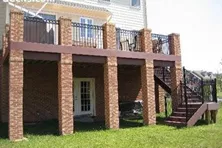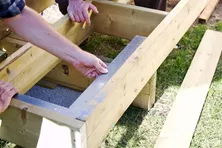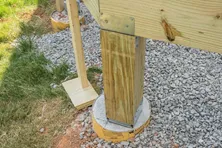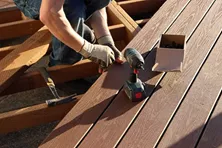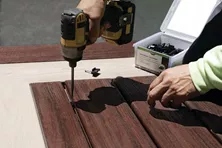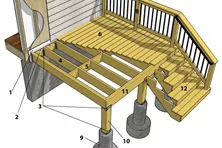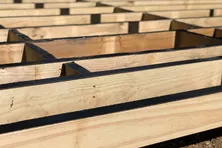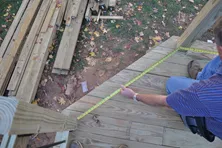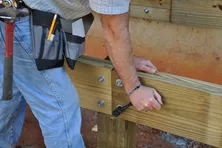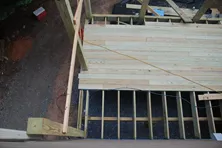How to Sister Deck Joists
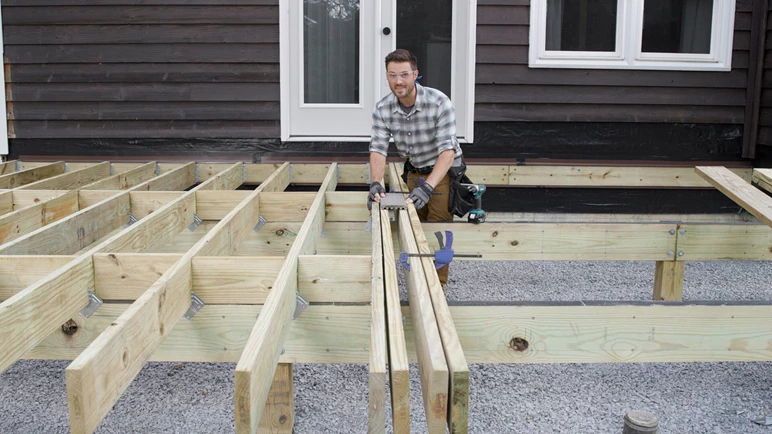
Sistering a joist onto another one simply means connecting one joist immediately next to another one. You may decide to do this to extend your deck, add additional strength in certain areas of your deck, or provide a solid framing member for decking as called for in decking instructions.
It’s important to realize sistering a joist is a major structural modification and if you’re not fully confident you’re doing the right thing, seek professional advice from a licensed contractor.
What Does Sistering or Joining Joints Mean?
The term “sistering” joists is the practice of overlapping two joists by a certain distance across a beam to create an extended joist. This is unusual in new deck construction and would only be necessary for very long spans that exceed the length of your longest boards.
Sistering can also mean adding 2x material to an existing joist to make up for irregular joist spacing. You might also sister on a full-sized joist to another in case there are planned concentrated loads up on the deck such as a hot tub, large masonry fountain, soil-filled planter boxes, or other very heavy objects.
When Do You Need to Sister Deck Joists?
Sistering joists are commonly used when adding to an existing deck or repairing a deck. In these cases, the overlapped joists help tie the framing together by combining the rigid members over a beam. Check with your local building department for the allowable length of the overlap area (not overhang) for your specific project. The side-by-side joists should be attached together by a nailing pattern which will be determined by your local building department and/or a structural engineer .If you are adding onto a deck, you must make sure the footings are large enough to support the added loads.
The fasteners used for sistering joists must be structural fasteners. Not all nails or even screws are rated for structural connections. It’s prudent to get a list of approved fasteners from your local building department. Keep in mind all fasteners must have a sufficient coating to resist decades of exposure to the corrosive brew created when rainwater mixes with treated lumber. Any decks in marine environments should use stainless steel-approved fasteners.
Does Sistering Joists Make Them Stronger?
The longer the overlap distance, the stronger the connection. Sistering joists almost always creates a stronger combined structural member. However, keep in mind the strength is determined by how strong each separate joist is on its own. Not all joists have the same strength.
The strength of wood is determined by both the wood species and the grade of the lumber. Refer to published span tables for information about species strength and grades. When extending deck joists, don’t hope all will be well. If you don’t have a strong background in structural design, get help from a professional. Sister joists that are not done properly can and do fail with catastrophic results.
Building Codes for Sistering Joists
The building code is a set of standards that can vary from city to city. Local code authorities can reject certain parts of the code or make them more stringent. Never assume something you read online is code-compliant in your area. Always meet with the local building inspector or plan examiner before you begin to plan your sister-joist project.
To add further frustration, the building code can change every three years. Currently, the building code doesn’t have a section on sistering joists. With this missing, how are you to know what you’re doing will provide a safe platform for twenty, thirty, or more guests at graduation, holiday, or wedding party to stand on?
Furthermore, when you sister deck joists, you’re creating a basic structural modification to the deck. Make sure to stay in the know of the rules provided by your local building code to ensure you’re sistering joists correctly.
How to Sister or Join Joists
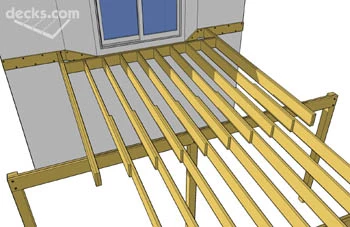
Many DIYers wonder how to join two joists together. First and foremost you start with the correct joist material matched to what you’re trying to accomplish. When extending floor joists, you need to first check to see if the existing joist is rotted.
Probe the existing joist, as well as the new one, with a flat head screwdriver. Compare the amount of pressure you have to use to penetrate the wood at the same depth in each joist. It’s imperative you know how to properly sister a deck joist and that the existing joist is in excellent or very good condition.
Step 1: Measure and Cut the New Joist
Refer to your local building code to understand how long the new sister joist must be when you’re extending an existing joist. Don't just guess or estimate. Always purchase the strongest joist material available to you when extending joists. Regular circular saws will cut all treated lumber.
To join two joists together of the same length, you simply use a measuring tape and pencil to mark a new joist the proper length and cut to length with a circular saw. You’ll need to use approved corrosion-resistant fasteners to connect the new joist to the existing one. A specific number of fasteners and a specific pattern must be used to provide the required strong connection. Once again, your local building department or licensed structural engineer will specify the type of fastener and placement or pattern for fastening.
Step 2: Fit the Sistered Joist
Joining deck joists together begins by making sure your new joist material is the same height as the existing joist. It’s also important to take into consideration the shape of the existing joist. The existing joist may have an excessive hump or crown. This means your new sistered joist must match this shape so the top surfaces of the joists match up and are flush. Check the fit before you drive any fasteners.
Step 3: Fasten the Sister Joist
Your local building code may have a section that calls out the fastener type and pattern required to meet minimum strength standards. Always realize the building code is a set of minimum building standards and you can always build better and stronger than the code.
Joining deck joists together is done using special timber screws, possibly lag bolts, or even through bolts. Realize the strength of the sistered joist relies entirely on being connected to an existing joist so the new sistered joist becomes one with the old joist. Simpson Strong-Tie is a manufacturer that makes a wide assortment of high-quality structural fasteners you might want to consider using for sister joists.
The fasteners must be approved by the local building department to resist long-term corrosion. You should use stainless steel fasteners if the sistered joist is in a marine environment subject to saltwater corrosion.
The number of fasteners depends on the width and length of the sistered joist. Often the fasteners are kept 1.5 inches from each edge and they might be spaced at 12 inches from one another, but check with your local building department for exact requirements. It’s best to predrill small pilot holes in the joists to prevent splitting caused by sharp-tipped fasteners. If the existing or sistered joist splits along the line of fasteners, the connection becomes very weak.
When Do You Sister a Rotted Deck Joist?
A rotted deck joist should set off a warning light in your head. If only a small portion of the joist is rotted, there is sure a chance rainfall would cause the rot to continue to expand consuming more and more of the original joist. If this happens, then your new sister joist will fail by default as the fasteners will have nothing but rotted wood around them.
This is why it’s never a good idea to sister a joist onto a partially rotted deck joist. In these situations it’s best to get professional advice. You may be setting the deck up for failure at a future time. It’s prudent to give serious consideration to replace rotted deck joists in all situations. Push the thoughts about how long does a sister joist have to be or how to add joists to an existing deck until such time as you know what has to happen with the rotted joist.
Get Started Planning Your Deck Today
Ready to take on sistering a joist? If you’re not comfortable yet with this project, it’s a good idea to seek professional advice or help with this type of project.
After this article you should know:
- Sistering joists is a major structural modification
Improperly sistered joists can lead to serious injury or death
- Your local building department can offer you the guidance to use the right materials, fasteners, and a plan of how to sister joists
- The actual process to sister a joist is DIY friendly
Ready to get started? Find materials near you with our where to buy tool, or search our certified list of contractors here.
How to Decorate Deck Support Columns
Browse some examples of decorative deck support posts for tall decks.
4 Tried and True Methods on How to Square a Deck Frame
Discover the secrets to perfectly squaring your deck frame. Our guide simplifies the process, ensuring your deck is flawlessly shaped and structurally sound.
How to Install Wood Deck Support Posts
Installing wood deck posts on top of concrete footings will provide additional support for your deck. We recommend using 6x6 posts due to their strength. Learn how install them at Decks.com.
How to Install Decking Over Existing Concrete Slab, Patio, or Porch
Discover the best techniques to build a deck over concrete, ensuring proper drainage and stability, while creating a beautiful outdoor space.
How to Install Composite Decking
Learn about how to install composite decking. Topics include expansion and contraction issues and hidden fastener systems.
Anatomy of a Deck
A comprehensive guide to help you learn the names and understand the functions of every part of your deck.
More Helpful Resources
Explore Articles by Topic

Footings
Information related to installing frost footings for decks

Framing
Learn structural framing methods

Decking
Learn about wood and composite decking materials

Stairs
An in-depth look at the complex issue of how to build stairs

Railings
How to install guardrails and handrails to meet IRC code

Features
An overview on water drainage, benches, planters and lights

Design
The basics of deck design

Planning
Learn about permits and working with contractors

Porches & Patios
Build a covered deck to enjoy all seasons

Ledger
Proper attachment techniques

Care
Maintain your deck to maintain your investment

Materials
An overview on water drainage, benches, planters and lights
Why is Joist Protection so Important for Your Deck?
If you’ve ever seen a piece of wood left out in the weather for any period of time, you know what happens: decay. Whether through wet rot, insect damage, or mildew, the fibers begin to break down.
How to Angle Corners and Joists
Learn how to frame a deck with angled or clipped 45-degree corners using a cantilever beam.
How to Splice a Deck Beam Over a Support Post
Follow our step by step tutorial for splicing a deck beam over a support post. Never split a beam in the center of a span.
What to Consider When Building A Wrap-Around Deck
Looking to add a wrap-around deck to your home but unsure of what the process involves? Check out this guide to learn more about top considerations when building a wrap-around deck.
How to Install Composite Decking
Learn about how to install composite decking. Topics include expansion and contraction issues and hidden fastener systems.
Explore Articles by Topic

Footings
Information related to installing frost footings for decks

Framing
Learn structural framing methods

Decking
Learn about wood and composite decking materials

Stairs
An in-depth look at the complex issue of how to build stairs

Railings
How to install guardrails and handrails to meet IRC code

Features
An overview on water drainage, benches, planters and lights

Design
The basics of deck design

Planning
Learn about permits and working with contractors

Porches & Patios
Build a covered deck to enjoy all seasons

Ledger
Proper attachment techniques

Care
Maintain your deck to maintain your investment

Materials
An overview on water drainage, benches, planters and lights




